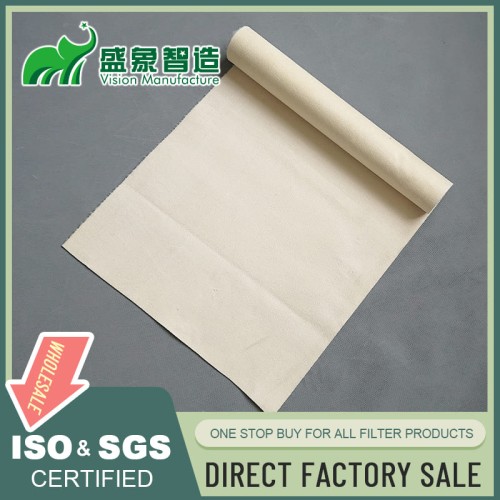
Non-Woven Filter Materials Improves Industrial Filtration Efficiency
Non-Woven Filter Materials: Revolutionizing Industrial Filtration Efficiency
In the rapidly advancing world of industrial filtration, non-woven filter materials are emerging as the cornerstone of innovation and performance. These materials, known for their versatility, durability, and filtration efficacy, are transforming the landscape of filtration processes across various industries. Here, we delve into the nuances of non-woven filter materials, outlining their properties, applications, and the cutting-edge technologies that enhance their functionality.
Understanding Non-Woven Materials
Non-woven materials are not your usual textiles. They are engineered fabrics made from fibers bonded not by traditional weaving but through more modern processes:
-
Meltblown Process: Produces fibers with fine diameters, contributing to high filtration efficiency due to their ability to capture minute particles.
-
Spunbond Process: Creates durable, strong fabrics ideal for demanding applications where longevity is key.
-
Needle-Punched Process: Offers exceptional density and depth, making these materials ideal for rigorous filtration tasks where contaminants vary widely in size.
-
Wet-Laid and Air-Laid Technologies: Provide unique characteristics like enhanced absorbency, making them versatile for specific filtration needs.
Types of Non-Woven Filter Materials
Exploring the types of non-woven filter materials reveals a variety of options each suited to particular applications:
-
Meltblown Fabrics: Celebrated for their fine fiber diameters, which contribute to high filtration capabilities. They are particularly effective in capturing particles down to sub-micron levels.
-
Spunbond Materials: Stand out with their impressive strength and durability, ideal for applications requiring long-lasting filters.
-
Needle-Punched Non-Wovens: Offer exceptional density and depth, making them suitable for more rigorous filtration tasks where capturing larger volumes of contaminants is necessary.
-
Wet-Laid and Air-Laid Technologies: Each provide unique characteristics, enhancing the versatility of non-woven fabrics in filtration applications. Wet-laid provides uniformity, while air-laid offers bulk and absorbency.
Advantages of Non-Woven Filter Materials
The benefits of non-woven materials are vast compared to traditional filter materials:
-
High Filtration Efficiency: Captures minute unwanted particles with remarkable effectiveness, ensuring cleaner air or liquid in industrial processes.
-
Increased Dirt-Holding Capacity: Allows for extended operational periods between maintenance, reducing downtime and increasing productivity.
-
Lower Pressure Drop: Reduces energy consumption in filtration systems, making them more cost-effective and environmentally friendly.
-
Durability: Withstands harsh industrial conditions, from high temperatures to chemical exposure, ensuring long-term performance.
-
Sustainability: Many non-woven materials are recyclable or biodegradable, contributing to a lower environmental footprint.
Applications of Non-Woven Filter Materials
Non-woven filters find their place in a myriad of applications, demonstrating their adaptability and scope:
-
Air Filtration: From HVAC systems to automotive air filters and industrial dust collection, enhancing indoor air quality.
-
Liquid Filtration: Used in sectors like water treatment, chemical processing, and the food and beverage industry for removing contaminants.
-
Oil and Fuel Filtration: Essential in maintaining purity in automotive and industrial operations, reducing engine wear and improving performance.
-
Medical and Healthcare: For creating sterile environments and manufacturing medical equipment where cleanliness and safety are paramount.
Choosing the Right Non-Woven Filter Material
Selecting the right non-woven filter material involves considering factors such as:
-
Particle Size: Ensure the material can capture the specific contaminants you need to filter, from large particles to sub-micron levels.
-
Flow Rate: Consider the volume of air or liquid passing through the filter to ensure it can handle your operational demands.
-
Chemical Compatibility: Match the filter material with the chemicals or substances being filtered to prevent degradation or contamination.
Comparison with Other Filter Media
When compared to other filtering media like woven fabrics and membrane filters, non-wovens offer a balanced package:
-
Cost-Effectiveness: Typically provide superior durability and efficiency at a lower cost.
-
Versatility: Adaptable to a wide range of filtration applications, from fine particle capture to bulk contaminant removal.
-
Durability: Non-woven materials often outperform woven or membrane filters in terms of longevity under harsh conditions.
Innovations in Non-Woven Filter Technology
The sector continues to evolve with:
-
Nanofiber Technology: Enhancing filtration properties by adding nanofibers to non-woven materials, increasing filtration efficiency for challenging environments.
-
Composite Non-Woven Materials: Combining different non-woven materials to create hybrid filters with robust properties for various applications.
-
Sustainable and Biodegradable Options: Reflecting a growing commitment to environmental sustainability, new materials are being developed to reduce the ecological footprint of filtration.
Environmental and Sustainability Considerations
Non-woven materials contribute significantly to sustainability efforts:
-
Recyclability: Their potential for reuse or recycling helps in minimizing waste.
-
Energy-Efficient Production: Advanced production processes aim to reduce energy consumption, lowering the overall carbon footprint.
Case Studies
Real-world applications:
-
Water Treatment Facility: Where non-woven filters significantly improved water clarity, reducing the need for chemical treatments.
-
Automotive Industry: Implementing non-woven filters in engine air intake systems to reduce particle contamination, improving engine life and performance.
Future Trends
The future of non-woven filter materials looks promising:
-
Smart Filtration: Integration of sensors and IoT for real-time monitoring and predictive maintenance.
-
Advanced Material Science: Developing materials with tailored properties for specific applications, enhancing both performance and sustainability.
-
Hybrid Technologies: Combining non-wovens with other advanced materials to create next-generation filters.
Conclusion
Non-woven filter materials are setting new standards in the filtration industry with their unparalleled efficiency and adaptability. As industries continue to seek more sustainable and cost-effective solutions, non-woven materials stand ready to meet these challenges, promising a future where performance and environmental responsibility go hand in hand.
Explore how Vision Filter can guide you in selecting the perfect non-woven filter material for your industrial needs. Contact Us to discuss your unique requirements and ensure top-tier performance in your operations.

